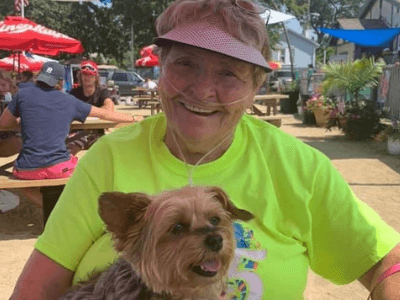
Sometimes the best treatment for a specific person’s lung cancer ends up being surgery. For Mo, that was a Wedge Resection surgery.
With all thanks to an annual Shenanigans Shuttle – a party bus celebrating both St. Patrick’s Day and her daughter’s birthday – Mo Welborn would soon discover that she had Non Small Cell Lung cancer, stage 2B.
It was March, 2014. Within days of the Shenanigan Shuttle, several revelers came down with bronchitis and other upper respiratory illnesses. Seeing how virulent this bug had proven to be, the moment she started to cough, Mo made an appointment to see her primary care physician. She was seen by a nurse practitioner who suspected bronchitis and prescribed a cough suppressant. As Mo was leaving, and almost as an afterthought, the nurse suggested Mo get a chest X Ray. That was on a Tuesday.
From Chest X Ray to CT Scan
Wednesday, Mo got a call from the nurse explaining that the radiologists saw something suspicious on the X-ray and sent her for a CT Scan. The concern was great enough that it was scheduled for the following day, Thursday.
On Friday, while driving home from work, Mo received a call from her doctor. In the time it took her to pull over to take the call, she had missed it. She called right back and was surprised that her doctor answered the phone right away.
“We need to have a discussion. The CT scan came back with a very suspicious spiculated mass, meaning it has uneven edges. It could be cancerous.”
Mo nearly dropped the phone. This was not the news she was expecting to receive. Shocked, she only wanted to know if it was a death sentence.
“It could be, but I don’t think it is.”
With a promise to regroup on Monday, the doctor told her to go home and relax. That night, having decided to keep the news to herself for a few days, Mo first went out to dinner with friends. It wasn’t until she arrived home that she allowed herself a little pity party, consumed with fear and the what-ifs that lay ahead.
And then she gave herself a strict talking to and told herself to:
“Pull myself up by the bootstraps.”
And she did.
Lung Wedge Resection Surgery a Success
Monday, less than a week after having noticed a cough, Mo and her adult son and daughter joined a conference call with what would become what she refers to as her incredible medical team.
A PET scan lit up and the cancer was growing rapidly. The decision was made to have Mo undergo a wedge resection. Wedge resection surgery removes the cancerous tumor, as well as a wedge-shaped section of the lung around the tumor. A wedge resection is less invasive than other surgical treatments for lung cancer and may be appropriate if the cancer, like Mo’s was, is relatively contained. Patients recovering from wedge resection surgery can expect to feel fatigue, pain, or shortness of breath. Still, Mo’s wedge resection was deemed a success, and the team, in an effort to eradicate any remaining cancer cells that may be hiding, suggested Mo undergo 12 rounds of chemotherapy.
Recovery After Lung Wedge ResectionTo No Evidence of Disease for Mo
Mo, who has underlying heart issues, diabetes, and happens to be allergic to many medications, had a tough time with the chemotherapy. The day after her first infusion she struggled with very difficult side effects. In fact, she was choking, coughing and gagging so hard that she ultimately broke a rib. Her medical team agreed to stop all chemotherapy. That was nearly six years ago and Mo is thrilled to be NED (no evidence of disease).
“I have been really, really lucky. Sure. I had lung cancer, but it was early. I listened to my body and surrounded myself with an incredible support group. Always remember to not give up, you will never walk alone.”
More about Mo aka Queeny Mo. (She earned this title having run the Buffalo Grove (IL) Festival for many years.) Mo is high spirited, a little bit sassy, has a terrific sense of humor, and does everything in her power to support any organization that is working toward a cure for lung cancer. She counts among her dearest friends many other lung cancer patients who refer to themselves as Lung Cancer Babes. Check out some of their stories: Bobbi Cohen, Ivy Elkins, Jill Feldman,Terry Gillespie, Juanita Segura, and Michelle Running.
A surgeon who specializes in surgeries for lung cancer patients is called a Thoracic Surgeon. Find out more about thoracic surgery – including lung wedge resection recovery.
When is Surgery an Option for Lung Cancer Treatment?
According to Dr. David Johnson, Chairman Emeritus of Lung Cancer Foundation of America’s Scientific Advisory Board,
“We have techniques for early detection of lung cancer that, frankly, didn’t exist 30 or 40 years ago. Today we have the ability to improve early detection, find tumors when they’re still surgically curable, and remove them.”
LCFA Scientific Advisory Board member, Dr. Denise Aberle, says,
“Most people when they are diagnosed with lung cancer are diagnosed at a late stage when the options for treatment are relatively few. There is, however, a period of time before symptoms develop that we call the “pre-clinical” phase of lung cancer. And, it is during that time that there is the possibility of screening an individual and detecting the disease at an early enough stage that a surgical or other local procedure could in fact cure them. And, cancer in its earliest stages are the most treatable. Those folks, currently, have the best odds of being able to survive and live well beyond their cancer diagnosis.”

